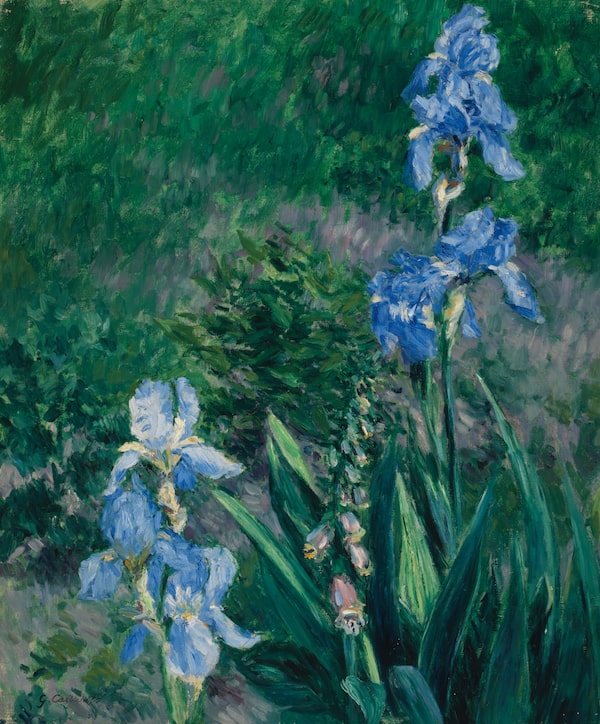
Iris bleus, jardin du Petit Gennevilliers (1892) by Gustav Caillebotte, was sold at a Toronto auction to a British buyer, but shipment of the painting was blocked by the Canadian Cultural Property Export Review Board, citing it’s importance to Canadian culture.Heffel Fine Art Auction House
A prominent auction house is arguing in court that the government gatekeepers for exporting art are too sweeping in their definition of what it means for something to be Canadian.
Heffel, which operates auction houses across the country, has asked the Federal Court of Canada to quash a decision by the Canadian Cultural Property Export Review Board that prevented the shipment of a French Impressionist painting last year.
The work, Iris bleus, jardin du Petit Gennevilliers (1892) by Gustave Caillebotte, was sold at a Toronto auction to a British buyer for $678,500.
In its decision, the review board said an object can be of “national importance,” even if it or its creator has no direct connection to Canada.
“Canada is a diverse country with a multitude of cultural traditions,” the decision said. “The loss of an object to Canada could significantly diminish the national heritage if that loss would deny a segment of the population exposure to or study of their cultural traditions or the cultural traditions of other Canadians.”
A private collector brought the Caillebotte canvas to Canada from France in the 1960s and has never exhibited it publicly.
In a submission to the court, Heffel’s lawyers argue that the review board’s interpretation of Canadian culture was too broad.
“[The law] requires the board to consider the degree of importance or connection to Canada’s heritage – our shared identity as a country – not to world arts or culture generally,” Heffel’s lawyers wrote. They also raised concerns with some of the board’s procedures.
The question of what art is important to Canadian heritage came up last month when the National Gallery of Canada announced it would sell Marc Chagall’s 1929 The Eiffel Tower on the global markets to raise money to purchase a 1779 Jacques-Louis David painting.
The National Gallery said the David, which has been in Canada for more than a century, was important to Canada’s “national heritage” and was at risk of being sold to a foreign buyer. Both Chagall and David are French painters and both works were created overseas. The Eiffel Tower, which came to Canada in 1956, was given an export permit so it could be sold at a Christie’s auction in New York. The National Gallery has since said it will cancel the sale because of public outcry.
Canada’s cultural property export regime was created in the seventies to keep important art or historical artifacts in the country. Export permits are required if the item is more than 50 years old, made by someone no longer living and if it meets other criteria, such as monetary value, that depend on the kind of object it is. The item must be judged to be of both outstanding significance and of national importance.
An application is assessed by a Canada Border Services Agency (CBSA) officer who relies on the advice of an expert in the field. In the case of the Heffel auction on Nov. 23, 2016, 16 items were sold that required permits and all of the applications were examined by Michelle Jacques, chief curator of the Art Gallery of Greater Victoria. According to court files, Ms. Jacques said two of those items should not leave the country: the Caillebotte painting and a work by Canadian artist Lawren Harris.
On Ms. Jacques’s advice, the CBSA denied export permits to both pieces on Dec. 19, 2016. Heffel appealed to the review board, which ultimately agreed with Ms. Jacques’s analysis.
In her report, Ms. Jacques argued that Caillebotte is a significant painter because of his association with French Impressionism, and that the movement influenced a generation of Canadian artists. She said his work is rare in Canada and this piece would likely have been exhibited had it been available.
The review board imposed a six-month delay on exporting the Caillebotte that started July 13, 2017, so that Canadian institutions had an opportunity to buy it. The Art Gallery of Ontario put in an offer for the Caillebotte on Sept. 8, 2017, that matched the auction’s sale price.
In a statement, auctioneer David Heffel said he was concerned there could be a chill on international buyers purchasing works in Canada if they aren’t sure they will be allowed to take the items out of the country.
The Harris piece was delayed for three months but has since left the country.
Government rules say no permit will be issued for an object for at least two years if a Canadian institution makes a “fair cash offer” and the exporter declines it.
The Federal Court is scheduled to hear the case on May 30.
 Chris Hannay
Chris Hannay